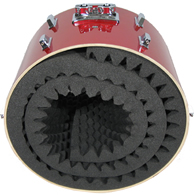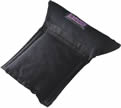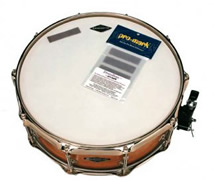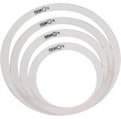 The art of drum muffling goes a lot deeper than just stuffing a bass drum with a bunch of pillows. Being able to add the perfect amount of muffling to any drum to get the best sound from it is a difficult technique – one that all drummers should know. Most drummers’ think of muting your drums with mufflers is a way to limit the sound of your drums. This is true to an extent; however there are many more reasons to do this. Muffling your drums can control the amount of resonance on your drums, as well as control the tone of certain notes. Here are a few tips on how to make you drum kit sound better with proper muffling, unlike the photo to the right!
The art of drum muffling goes a lot deeper than just stuffing a bass drum with a bunch of pillows. Being able to add the perfect amount of muffling to any drum to get the best sound from it is a difficult technique – one that all drummers should know. Most drummers’ think of muting your drums with mufflers is a way to limit the sound of your drums. This is true to an extent; however there are many more reasons to do this. Muffling your drums can control the amount of resonance on your drums, as well as control the tone of certain notes. Here are a few tips on how to make you drum kit sound better with proper muffling, unlike the photo to the right!
*If you are having troubles figuring out which drum is which, watch this video on
drum related terms, where you will learn what each drum is called and where it is positioned!
The first drum that every drummer muffles is the bass drum. This is a very popular habit since the bass drum usually carries a lot of overtones and resonance. Because this voice is supposed to sound quick and powerful, most drummers put something in the drum to dampen the sound of it. Be careful though, there is a wrong way to muffle your bass drum; so before you go crazy with blankets and
pillows, read this first!
 First off, if you have the extra cash around, you may want to consider buying specific bass drum muffling products. There are a few different types of pads or rings you can get for your bass drum that help control the “thump” of your drum. So go out to your local music store and see if you can find one that fits your budget. A great product is the Evans EQ pad; which is a custom muffling product that fits right on the bottom of the bass drum. There are other products like a drum ring that fits around the batter head of the bass drum to control the sound. All of these are great options if you have the cash to invest.
First off, if you have the extra cash around, you may want to consider buying specific bass drum muffling products. There are a few different types of pads or rings you can get for your bass drum that help control the “thump” of your drum. So go out to your local music store and see if you can find one that fits your budget. A great product is the Evans EQ pad; which is a custom muffling product that fits right on the bottom of the bass drum. There are other products like a drum ring that fits around the batter head of the bass drum to control the sound. All of these are great options if you have the cash to invest.
If you would rather skip that step, then do not worry; there are many options that cost next to nil that will give you very similar results. You need to remember when you’re muffling a drum the whole point is to control the air flow in the shell. If you fill the whole drum with pillows and blankets, you will totally cut off all air flow. The bass drum will eventually sound dead and flat – not what you want. The trick is to put a small amount of muffling in there. Try placing one pillow or blanket resting on the bottom of the drum. This way you get bit more control of the air flow, as well as the resonance on the drum head without killing the sound. If you cannot get a decent sound right away, try moving the pillow around; just try to keep it from touching the batter head. If you are still havign trouble getting a decent sound from your bass drum, read this article on how to tune a drum set; this will teach you how to properly tune your bass drum!
 The next step is to muffle your snare drum and toms. Now although the concept is the same as the bass drum, the method is totally different. It is not recommended you place a pillow or blanket inside of your snare drum. So what are the alternatives? Well there are a few products that work wonders for controlling the sound of your drums. The first product I would recommend is Drum Gum. Drum Gum is a sticky gel that is placed on the batter head of a drum to control the resonance and overtones. This can be a lifesaver for snare drums and low tom drums. Place a small patch of drum gum anywhere on the drum head (preferable where you will not hit it) and listen to the difference.
The next step is to muffle your snare drum and toms. Now although the concept is the same as the bass drum, the method is totally different. It is not recommended you place a pillow or blanket inside of your snare drum. So what are the alternatives? Well there are a few products that work wonders for controlling the sound of your drums. The first product I would recommend is Drum Gum. Drum Gum is a sticky gel that is placed on the batter head of a drum to control the resonance and overtones. This can be a lifesaver for snare drums and low tom drums. Place a small patch of drum gum anywhere on the drum head (preferable where you will not hit it) and listen to the difference.

Another product that works very well is drum rings. These are usually one inch thick rings that fit right around the batter head of the drum. These are great because they are inexpensive, and really cut down the resonance of any drum. You can get them for any size drum, and they usually do not interfere with your playing. Try them both out and determine which one is more suitable for your style of playing.
These are all great ways to increase the sound of your drum set. Remember that not all drums need to be muffled, so do not go out and mute all of your drums. Instead, listen to the tones you get on each drum and determine weather or not you need drum muffling. You will be surprised at how different your drums will sound with the correct amount of muffling!
Learn more about drum muffling with Mike Michalkow's complete Drumming System!
If you are interested in playing your bass at double your current speed, with more control, and precision the Bass Drum Secrets Pack is exactly what you need. Check out www.BassDrumSecrets.com or click the image below.


Enter your email to get sheet music for 100 of drumming’s biggest songs FREE.